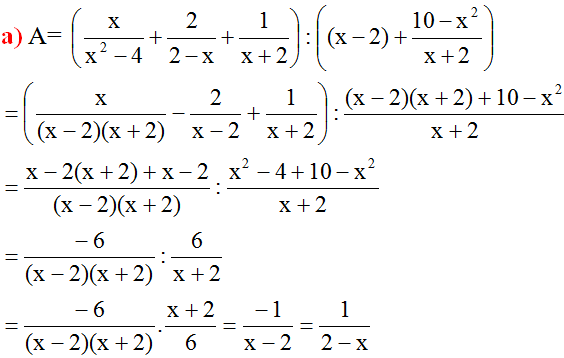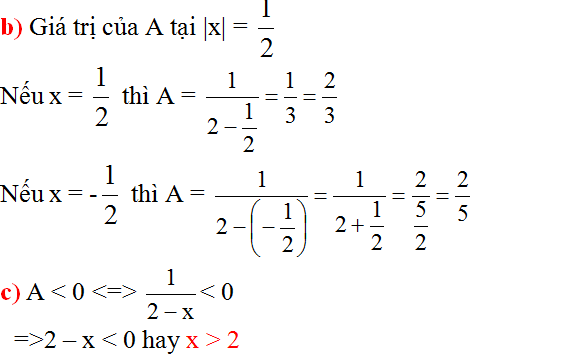Hãy nhập câu hỏi của bạn vào đây, nếu là tài khoản VIP, bạn sẽ được ưu tiên trả lời.

Lời giải:
ĐKXĐ: \(x\neq \left\{2;\pm 3\right\}\)
a) Ta có:
\(P=\left(\frac{x^2-3x}{x^2-9}-1\right):\left(\frac{9-x^2}{x^2+x-6}-\frac{x-3}{2-x}-\frac{x-2}{x+3}\right)\)
\(P=\left(\frac{x(x-3)}{(x-3)(x+3)}-1\right):\left(\frac{(3-x)(3+x)}{(x-2)(x+3)}-\frac{3-x}{x-2}-\frac{x-2}{x+3}\right)\)
\(P=\left(\frac{x}{x+3}-1\right):\left(\frac{3-x}{x-2}-\frac{3-x}{x-2}-\frac{x-2}{x+3}\right)\)
\(P=\frac{x-(x+3)}{x+3}:\left(-\frac{x-2}{x+3}\right)=\frac{-3}{x+3}.\frac{x+3}{-(x-2)}=\frac{3}{x-2}\)
b) \(x^3-3x+2=0\)
\(\Leftrightarrow (x^3-x)-2(x-1)=0\)
\(\Leftrightarrow x(x-1)(x+1)-2(x-1)=0\)
\(\Leftrightarrow (x-1)(x^2+x-2)=0\)
\(\Leftrightarrow (x-1)[(x^2-1)+(x-1)]=0\)
\(\Leftrightarrow (x-1)^2(x+2)=0\) \(\Leftrightarrow \left[\begin{matrix} x=1\\ x=-2\end{matrix}\right.\)
Với \(x=1\Rightarrow P=\frac{3}{1-2}=-3\)
Với \(x=-2\Rightarrow P=\frac{3}{-2-2}=\frac{-3}{4}\)
c)
\(P=\frac{3}{x-2}\in\mathbb{Z}\Leftrightarrow 3\vdots x-2\)
\(\Leftrightarrow x-2\in \text{Ư}(3)\Rightarrow x-2\in\left\{\pm 1; \pm 3\right\}\)
\(\Leftrightarrow x\in \left\{3,1,5,-1\right\}\)
Do \(x\neq 3\Rightarrow x\in \left\{-1,1,5\right\}\)

a) Rút gọn :
P = \(\left(\dfrac{2x}{x+3}+\dfrac{10}{x-3}-\dfrac{2x^2+14}{x^2-9}\right):\dfrac{4}{x+3}\)
\(ĐKXĐ:\left\{{}\begin{matrix}x+3\ne0\\x-3\ne0\end{matrix}\right.\Rightarrow\left\{{}\begin{matrix}x\ne-3\\x\ne3\end{matrix}\right.\)
Ta có : \(P=\left[\dfrac{2x\left(x-3\right)}{\left(x+3\right)\left(x-3\right)}+\dfrac{10\left(x+3\right)}{\left(x+3\right)\left(x-3\right)}-\dfrac{2x^2+14}{\left(x+3\right)\left(x-3\right)}\right].\dfrac{x+3}{4}\)
\(P=\dfrac{2x^2-6x+10x+30-2x^2-14}{\left(x+3\right)\left(x-3\right)}.\dfrac{x+3}{4}\)
\(P=\dfrac{4x+16}{4x-13}=\dfrac{x+4}{x-3}\)
b) |x| = 3 => \(\left\{{}\begin{matrix}\left|x\right|=3khix\ge0\\\left|x\right|=-3khix< 0\end{matrix}\right.\)
* TH1 : x \(\ge0\)
\(P=\dfrac{x+4}{x-3}=\dfrac{3+4}{3-3}\left(koTMvìmẫu\ne0\right)\)
* TH2 : x < 0
\(P=\dfrac{x+4}{x-3}=\dfrac{-3+4}{-3-3}=\dfrac{-1}{6}\left(Tm\right)\)
c) Để P = \(\dfrac{-1}{2}\) thì :
\(\dfrac{x+4}{x-3}=\dfrac{-1}{2}\)
\(\Leftrightarrow2x+8=3-x\)
\(\Leftrightarrow2x+x=-8+3\)
\(\Leftrightarrow3x=-5\Rightarrow x=\dfrac{-5}{3}\)
d) P \(\le\) 2
<=> \(\dfrac{x+4}{x-3}\le2\)
\(\Leftrightarrow\dfrac{x+4}{x-3}-\dfrac{2x-6}{x-3}\le0\)
\(\Leftrightarrow\dfrac{10-x}{x-3}\le0\)
Lập bang xét dấu và tìm x nhé!!

\(A=\left(\dfrac{x+y}{y}+\dfrac{2y}{x-y}\right)\cdot\dfrac{-\left(x-y\right)}{x^2+y^2}+\left(\dfrac{2x^2+2-2x^2+x}{2\left(2x-1\right)}\right)\cdot\dfrac{1-2x}{x+2}\)
\(=\dfrac{x^2-y^2+2y^2}{y\left(x-y\right)}\cdot\dfrac{-\left(x-y\right)}{x^2+y^2}+\dfrac{x+2}{2\left(2x-1\right)}\cdot\dfrac{-\left(2x-1\right)}{x+2}\)
\(=\dfrac{-1}{y}+\dfrac{-1}{2}=\dfrac{-2-y}{2y}\)

a) \(ĐKXĐ:x\ne\pm3;x\ne-6\)
Với \(x\ne\pm3;x\ne-6\), ta có:
\(P=\left(\dfrac{x}{x-3}-\dfrac{2}{x+3}+\dfrac{x^2}{9-x^2}\right):\dfrac{x+6}{3x+9}\\ =\left(\dfrac{x\left(x+3\right)}{\left(x-3\right)\left(x+3\right)}-\dfrac{2\left(x-3\right)}{\left(x+3\right)\left(x-3\right)}-\dfrac{x^2}{\left(x+3\right)\left(x-3\right)}\right)\cdot\dfrac{3\left(x+3\right)}{x+6}\\ =\dfrac{x^2+3x-2x+6-x^2}{\left(x+3\right)\left(x-3\right)}\cdot\dfrac{3\left(x+3\right)}{x+6}\\ =\dfrac{x+6}{\left(x+3\right)\left(x-3\right)}\cdot\dfrac{3\left(x+3\right)}{x+6}\\ =\dfrac{3}{x-3}\)
Vậy \(P=\dfrac{3}{x-3}\) với \(x\ne\pm3;x\ne-6\)
b) Ta có: \(2x-\left|4-x\right|=5\)
+) Nếu \(x\le4\Leftrightarrow2x-\left(4-x\right)=5\)
\(\Leftrightarrow2x-4+x=5\\ \Leftrightarrow3x=9\\ \Leftrightarrow x=3\left(Tm\right)\)
+) Nếu \(x>4\Leftrightarrow2x-\left(x-4\right)=5\)
\(\Leftrightarrow2x-x+4=5\\ \Leftrightarrow x=1\left(Ktm\right)\)
Với \(x\ne\pm3;x\ne-6\)
Khi \(x=3\left(Ktm\right)\rightarrow\text{loại}\)
Vậy khi \(2x-\left|4-x\right|=5\) không có giá trị.
c) Với \(x\ne\pm3;x\ne-6\)
Để P nhận giá trị nguyên
thì \(\Rightarrow\dfrac{3}{x-3}\in Z\)
\(\Rightarrow3⋮x-3\\ \Rightarrow x-3\inƯ_{\left(3\right)}\)
Mà \(Ư_{\left(3\right)}=\left\{\pm1;\pm3\right\}\)
Lập bảng giá trị:
| \(x-3\) | \(-3\) | \(-1\) | \(1\) | \(3\) |
| \(x\) | \(0\left(TM\right)\) | \(2\left(TM\right)\) | \(4\left(TM\right)\) | \(6\left(KTM\right)\) |
Vậy để P nhận giá trị nguyên
thì \(x\in\left\{0;2;4\right\}\)
d) Với \(x\ne\pm3;x\ne-6\)
Ta có : \(P^2-P+1=\dfrac{9}{\left(x-3\right)^2}-\dfrac{3}{x-3}+1\)
Đặt \(\dfrac{3}{x-3}=y\)
\(\Rightarrow P^2-P+1=y^2-y+1\\ =y^2-y+\dfrac{1}{4}+\dfrac{3}{4}\\ =\left(y^2-y+\dfrac{1}{4}\right)+\dfrac{3}{4}\\ =\left(y-\dfrac{1}{2}\right)^2+\dfrac{3}{4}\)
Do \(\left(y-\dfrac{1}{2}\right)^2\ge0\forall y\)
\(\Rightarrow P^2-P+1=\left(y-\dfrac{1}{2}\right)^2+\dfrac{3}{4}\ge\dfrac{3}{4}\forall y\)
Dấu "=" xảy ra khi:
\(\left(y-\dfrac{1}{2}\right)^2=0\\ \Leftrightarrow y-\dfrac{1}{2}=0\\ \Leftrightarrow y=\dfrac{1}{2}\\ \Leftrightarrow\dfrac{3}{x-3}=\dfrac{1}{2}\\ \Leftrightarrow x-3=6\\ \Leftrightarrow x=9\left(TM\right)\)
Vậy \(GTNN\) của biểu thức là \(\dfrac{3}{4}\) khi \(x=9\)

B3;a,ĐKXĐ:\(x\ne\pm4\)
A=\(\left(\dfrac{4}{x-4}-\dfrac{4}{x+4}\right)\dfrac{x^2+8x+16}{32}=\left(\dfrac{4x+16}{x^2-16}-\dfrac{4x-16}{x^2-16}\right)\dfrac{x^2+2.4x+4^2}{32}=\left(\dfrac{4x+16-4x+16}{x^2-16}\right)\dfrac{\left(x+4\right)^2}{32}=\left(\dfrac{32}{x^2-16}\right)\dfrac{\left(x+4\right)^2}{32}=\dfrac{32\left(x+4\right)^2}{32.\left(x-4\right)\left(x+4\right)}=\dfrac{x+4}{x-4}\\ \\ \\ \\ \\ \\ b,Tacó\dfrac{x+4}{x-4}=\dfrac{1}{3}\Leftrightarrow3x+12=x-4\Leftrightarrow x=-8\left(TM\right)c,TAcó\dfrac{x+4}{x-4}=3\Leftrightarrow x+4=3x-12\Leftrightarrow x=8\left(TM\right)\)

Bài 1:
a: \(A=\dfrac{x^4+x^3+x+1}{x^4-x^3+2x^2-x+1}=\dfrac{x^3\left(x+1\right)+\left(x+1\right)}{x^4-x^3+x^2+x^2-x+1}\)
\(=\dfrac{\left(x+1\right)\left(x^3+1\right)}{\left(x^2-x+1\right)\left(x^2+1\right)}=\dfrac{\left(x+1\right)^2}{x^2+1}\)
Để A=0 thì x+1=0
hay x=-1
b: \(B=\dfrac{x^4-5x^2+4}{x^4-10x^2+9}=\dfrac{\left(x^2-1\right)\left(x^2-4\right)}{\left(x^2-1\right)\left(x^2-9\right)}=\dfrac{x^2-4}{x^2-9}\)
Để B=0 thi (x-2)(x+2)=0
=>x=2 hoặc x=-2

a) ĐKXĐ \(\left\{{}\begin{matrix}x\ne-3\\x\ne2\end{matrix}\right.\)
\(A=\dfrac{x+2}{x+3}-\dfrac{5}{\left(x+3\right)\left(x-2\right)}-\dfrac{1}{x-2}\)
\(=\dfrac{\left(x+2\right)\left(x-2\right)-5-\left(x+3\right)}{\left(x+3\right)\left(x-2\right)}=\dfrac{x^2-x-12}{\left(x+3\right)\left(x-2\right)}=\dfrac{\left(x-4\right)\left(x+3\right)}{\left(x+3\right)\left(x-2\right)}\)
\(=\dfrac{x-4}{x-2}\)
b) Để A > 0 thì \(\dfrac{x-4}{x-2}>0\Rightarrow\left[{}\begin{matrix}x< 2\\x>4\end{matrix}\right.\)
Kết hợp ĐK thì \(\left[{}\begin{matrix}x< 2,x\ne-3\\x>4\end{matrix}\right.\)
c) \(A=\dfrac{x-4}{x-2}=1+\dfrac{-2}{x-2}\)
Để A nguyên thì \(x-2\inƯ\left(-2\right)=\left\{-2;-1;1;2\right\}\)
\(\Rightarrow x\in\left\{0;1;3;4\right\}\)
Khi thay vào A để A dương thì \(x\in\left\{0;1\right\}\)
Vậy để A nguyên dương thì \(x\in\left\{0;1\right\}\)
Hok tốt!

Lời giải của bạn Nhật Linh đúng rồi, tuy nhiên cần thêm điều kiện để A có nghĩa: \(x\ne\pm2\)


a: \(Q=\dfrac{x\left(x+1\right)}{\left(x-1\right)^2}:\dfrac{x^2-1+x+2-x^2}{x\left(x-1\right)}\)
\(=\dfrac{x\left(x+1\right)}{\left(x-1\right)^2}\cdot\dfrac{x\left(x-1\right)}{x+1}=\dfrac{x^2}{x-1}\)
b: |x|=1/3 thì x=1/3 hoặc x=-1/3
Khi x=1/3 thì \(Q=\left(\dfrac{1}{3}\right)^2:\left(\dfrac{1}{3}-1\right)=-\dfrac{1}{6}\)
Khi x=-1/3 thì \(Q=\left(-\dfrac{1}{3}\right)^2:\left(-\dfrac{1}{3}-1\right)=-\dfrac{1}{12}\)
c: Để Q là số nguyên thì \(x^2-1+1⋮x-1\)
=>\(x-1\in\left\{1;-1\right\}\)
=>x=2
d: Để Q=4 thì x^2=4x-4
=>x=2